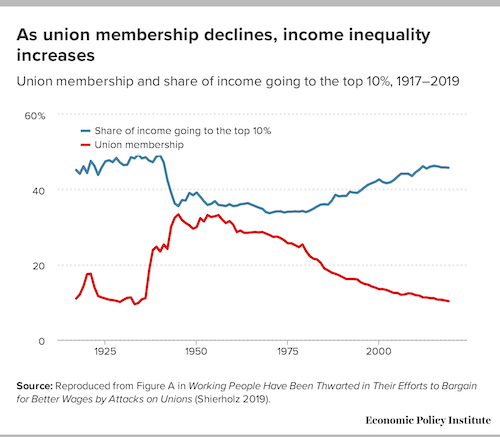The Bureau of Labor Statistics report on unionization rates in 2020 shows how a union can make a real difference in a working person’s life, even – or especially – during a once-in-a-lifetime global pandemic.
According to the numbers, which were released in January, the percent of wage and salary workers who were members of unions in 2020, also known as the union membership rate, increased by 0.5 percentage points to 10.8%. This occurred despite historic unemployment numbers overall because union workers suffered fewer job losses than nonunion workers did during the pandemic.

|
The decades-long decline in union membership has coincided with rising income inequality – the highest in U.S. history according to the U.S. Census Bureau.
Image credit: EPI
|
“These numbers show just how critical the protections of a union are,” said International President Lonnie R. Stephenson. “Having a voice and being able to negotiate terms like furloughs, paid sick time and severance are incredibly important. And in a year like 2020 that was on full display.”
In addition to the power of a collective voice and a contract, the Economic Policy Institute points out that another reason for the increased unionization rate is because of a “pandemic composition effect.” This phenomenon is exemplified by certain industries, like hospitality and leisure that have low unionization rates, experiencing more job loss than industries like the public sector, which have higher concentrations of union workers.
Yet, even within the same industry union members fared better. Wholesale and retail trade, one of the hardest-hit sectors, shed more than 700,000 positions but still gained 46,000 union members.
“One of the headlines from this is that union membership provides protections against the harshest layoffs at a time of economic crisis,” Rebecca Givan, professor of labor studies and employment relations at Rutgers University, told the Washington Post.
In the construction industry, the BLS reported that the number of wage and salary construction workers with union membership declined from just over 1 million in 2019 to 993,000 in 2020, but the percentage increased slightly from 12.6% to 12.7%. Additionally, nonunion median weekly wages in 2019 were almost 29% less than the average union wage.
EPI also noted that while the unionization rate for public sector workers at the state and local level increased, the opposite happened at the federal level, which they attribute to then-President Trump’s antiunion actions including multiple executive orders aimed at weakening unions.
Government Employees Director Paul O’Connor also points to a lack of support among Congress, particularly in the Senate, then controlled by Kentucky Republican Sen. Mitch McConnell.
“Presidential executive orders do not require U.S. House or Senate concurrence, but our elected officials didn’t stand with the IBEW or other federal labor unions to fight the rampant, widespread injustice of Trump’s orders,” O’Connor said. “This became a deflating reality for our federal sector brothers and sisters. Apathy rose as morale diminished.”
O’Connor said that lack of support hampered the efforts of IBEW leaders and allies to fight back, which some members then misinterpreted as the unions not doing enough, so they took advantage of their open shop status and left.
“Our local union leaders tirelessly, day in and day out, displayed grit and determination, and the IBEW administration supported them every step of the way,” O’Connor said. “The degree of their success was not a reflection of the intensity with which they defended their membership. Instead, it was more of a reflection of the values agencies placed on our federal workforce and the intrinsic nature of quality labor-management relationships.”
The economic upheaval of 2020 may have laid bare the difference a union makes, but the desire to join one started before the coronavirus hit. A survey taken in 2017 by PBS and the National Opinion Research Corporation found that nearly half of workers would join a union if given the chance – a four-decade high for the question. As PBS reported, the scale of this shift indicates that 58 million American workers would vote for representation if they could, quadrupling the current number.
Union popularity was also found by Gallup in its 2020 poll that showed overall support at 65%, the highest in a decade.
As EPI noted, the union coverage rate is less than half of what it was roughly 40 years ago and this has coincided with rampant inequality, the worst in U.S. history according to Census Bureau data. From 1979 to 2019, the wages of the top 1% grew nearly 160.3%, while the wages of the bottom 90% combined grew just 26%.
“It’s no coincidence that things get worse for working people when unions are under attack,” Stephenson said. “Unions are the best tool we have for leveling the playing field and giving everyone a real shot at the American Dream. And the best thing we can do right now to get more people organized is to pass the PRO Act.”
The Protecting the Right to Organize, or PRO, Act is federal legislation that would make it easier for people to join a union while also keeping unscrupulous employers from meddling in the process. It’s been called the most important piece of labor legislation in more than 70 years and it passed the House of Representatives in March. President Joe Biden has signaled his support, but it faces an uphill battle in the Senate.